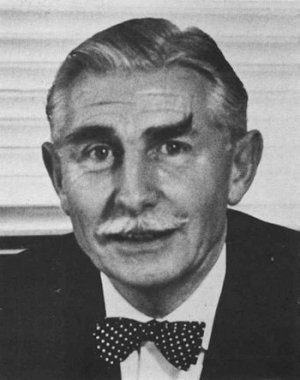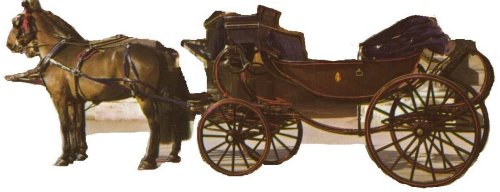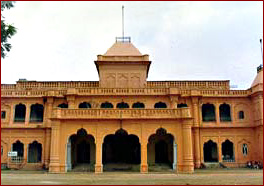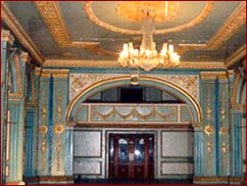| Air
Conditioning the Khasbagh Palace Rampur India |

 |
J A E Heard (known as Archie) joined Carrier Engineering Co. of London in the 1920s and trained in the USA before working in India. His account of the time he spent supervising the installation of the air conditioning system at the Khasbagh Palace in India is both informative and amusing. He served as a Lt-Col in India during WW II; afterwards returning to work in London. He became Sales Director and later Managing Director, continuing with Haden Carrier until his retirement. Archie Heard became the first chairman of the Heritage Group (which was previously known as the IHVE Archaelogy Working Party) |
| THE AIR CONDITIONING OF THE KHASBAGH PALACE | ||
|
|
It had all been building up to this; the year in the United States of America learning the basic principles of the new science of Air Conditioning; the voyage through Suez to Bombay; the blue train to Calcutta; the mail train to Delhi; the months of 1930 working on the installations of air conditioning for the buildings in New Delhi; the Secretariats; the legislative assembly and Vice Regal Lodge; all had been essential steps in the background to this experience. In
1931 from head office in
London came instructions to contact at Marden’s Hotel in
Delhi a
representative
of a well-known firm of London interior decorators. From
him came the
first
information about Khasbagh Palace. A trip to Rampur was
arranged in
conjunction
with the Architect and interior decorator to meet with
the Nawab (The
Prince of
Rampur) and discuss the possibility of air conditioning
for the new
Palace.
The night’s
journey by train has gone from my
memory, but
not the arrival at Rampur Station. It was early morning.
Dawn had only
just
brought to an end the cool of the night. The station was
empty. Puran
my bearer
gathered some coolies and we proceeded with my baggage
out of the
station’s
dimness into the now bright sunshine of the outside
road. Waiting
for me – it had to be for
me because I was the only passenger that had dismounted
– was a horse
drawn
Victoria with splendidly garbed – main scarlet and light
khaki driver
and
out-rider. A few steps were lowered for me to mount into
the Victoria
and I
arranged myself on to the back seat. Puran sat up front
with the
driver. The
out-rider sprang up somehow behind me. There was plenty
of room for
three more
passengers but at a nod from me we were clapping off
down the road –
dusty and
beginning to be warm.  The
place at first
seemed to be
deserted but as we progressed the odd Rampuri appeared
at the roadside
and
immediately bent double in homage – head almost in the
dust. I found
myself
swinging my topee off in wide salute true Kipling
manner.
There is no impression of colour – unless dust has a colour – everywhere dust had settled to make trees, grass already burnt by the sun the same colour as the earth and roads. But as the carriage swings round the right hand bend it brings a flat dark green patch of a long mango grove into sight and then within a few minutes from the roadway a long low white building verandahed and turreted, set back from the roadway. The Victoria swings through the wide gateway and rolls to a stop under the porch way. Thus I had arrived for the first of many visits to the Guest House Rampur. |
|
From
my
new friends I learnt more about the
Nawab. It seems that the young Nawab had a party
in Mussorrie. He had
been
greatly humiliated by his father – a suspicious
old man expecting
everyone to
try and kill him, so that even his loo was fixed
with mirrors so that
he could
make his own diagnosis of his condition. Finally
the boy, his heir, it
is said
had been sent out of the State and banished to
Mussorrie on an income
of 1000
rupees a month (about £80). A headstrong boy
pampered in the
Zenana did not
take kindly to this treatment so that
the hatred for his
father merely
increased with the banishment. Then his
Father died
quite suddenly. If
there
were any foul play it did not get revealed and
the Government of India
duly
informed the boy in Mussorrie he was the
rightful Nawab. His elation
was to be
expected and erupted it was said, in a series of
flamboyant gestures to
show
the difference of his new circumstances
including a party for a large
number of
Europeans, to each man a gold cigarette case, to
each woman a pearl
necklace.
Eventually his extravagance was brought to the
notice of
the Government of
India who tweaked his ear, said he
was not to be a naughty boy and made him go back to
the State, to limit
the
display of his expenditure outside.
Back in his own State – he was just excited enough to start a round of State Banquets. But soon these failed to sustain the wish to show his father was gone and that he was the Nawab. Then one evening sitting under a large shamiana outside the Palace his father had built, he remarked that he also would like to build a Palace. Someone incurred his wrath by remarking he already had several? His quick remarks they had been his Fathers showed how he still felt. Then someone said - why not pull one of the Palaces down and build another. This pleased him and he said why not the one in front of him – this was received with applause and almost immediately instructions were given to pull down the old Palace and build a new one. There was seen the effect of many hands because that old Palace simply disappeared in a matter of days. And during those following days the design of the new Palace was the subject of almost continuous talks – His Highness having made up his mind – this means that the wish had been voiced – was impatient for its completion. |
|
When I first saw the ground on which the Palace was to be built there were signs of foundations being built to obviously incomplete drawings, and I learnt only as we progressed the extent that each idea was taken up by the enthusiasm of the Nawab. Eventually it was clear that the Palace was going to have every thing modern that could be thought of – it was to be completely air conditioned – to have lifts – separate lifts to take His Highness down to the tunnel which would take him from his rooms in the Palace to the Zenana nearby – the Zenana was to be more or less rebuilt and an enclosed Zenana swimming pool was to be heated and air conditioned. The
site
became a hive of industry and like a miner’s gold
rush it drew the sellers from the world’s market
places. But the young
prince
had a suspicious nature that made him distrust
strangers however glib –
his
Chief Minister was so canny that he was always called
Macdonald for his
natural
likeness to the clan of Scotsmen – so he kept his
entourage to the few
who had
been with him in his first disappointments and through
them selected
the whims
of his youthful wishes. It became the Prince’s whole
life. The morning
audience
was procession around the building. Luncheon was taken
in the huge
shamiana in
front of the site. The late afternoon audience was
again a procession
around
the building. So the Palace daily increased in size
and its design in
magnificence. It was
obvious that
the interior decoration with
its heavy plaster cornices, ornate in design
would require a special
treatment
as far as air distribution was concerned.
Furthermore it was obvious
that
dealing with a Prince one would have to be
prepared for the control of
the air
conditioning to be as personal as possible. In
those days of the early
thirties
there was no modern automatic controls and so
the final arrangement had
to be
that which would be the most up to date at
that time. Finally the
design
introduced the first use of a slotted type
induction air distribution
(actually
incorporated into the fibrous plaster cornices
of the ceiling to a
plenum box
along the length of the room and with cornice
lighting below). To avoid
any
problems from noise and to reduce air
resistance, the air velocities in
the air
ducts were kept extremely low. Main ducts were
designed at 900-1200 fpm
while
branch ducts to outlets were at 500-600 fpm.
This resulted in enormous
builders
work ducts and quite extensive civil
engineering problems. The room
damper
control was connected by Bowden cable to the
duct in the main masonry
duct
below. In consequence of the requirements for
this damper control,
the
main
ducts all constructed in masonry came
to look like underground railway systems with
their lights,dampers and
pulleys, each sub-divided in the main duct to
control all the air for
all the
wall chases cut into the walls serving one room,
and enabling all the
air for
the room to be controlled from a single handled
device (ornamental to
match the
highly decorative Palace rooms). The air conditioning plants of that 1930 period consisted of heavy duty equipment comprising Fresh and Return Mixing Dampers, pneumatically operated, Water Spray Type Humidifier / Dehumidifier with centrifugal pumpset, three way mixing valve pneumatically controlled, and pot strainer, Eliminators, Steam Air Heater Battery pneumatically controlled, and centrifugal air supply fan. The atomised spray of water served both as a heat transfer agent as an air filtering system. The Refrigeration plants consisted of ammonia compression equipment manufactured by Vilter of USA. Bauldelot coil type evaporated contained within a builders work insulated chamber with shell and tube condenser. The re-circulated water system provided the heat exchange requirements and the cooling requirements were regulated by adjustment of cold to re-circulated water to preserve a fixed dew point temperature. Reheat was regulated by sensing the temperature of the return air. There was a separate plant for each building, no zonal control but volume control by damper for each individual room or area. The very thick masonry construction provided an excellent time lag which helped to offset the heavy sun load during the hot months. Compared with modern equipment, it was heavy, bulky, with a few automatic devices but at the time compared with the then existing more primitive forms of cooling and heating. The
supervision
required with all the air distribution in
masonry work was extensive. It was essential that the
chases in the
masonry
walls had an inner surface adequately smooth, and the
corners rounded
to avoid
air resistance and turbulence. Indian masons became quite skilled at the inner plastering using a template to achieve the desired objective. The design had to be modified as the Prince’s whims in the choice of decoration varied and it was a great test of ingenuity. |
|
As the
magnificence of the work increased so the payments
required often caused havoc to the Treasury and Finance
Minister would
be hard
pressed to keep contractors working. When the Palace was
up to first
floor
level, His Highness was on his daily tour of inspection
when he
questioned me
on the slowness of some of the provisions for the air
conditioning. I
referred
jocularly – in a quick decision to try a new gambit – to
the progress
being in
line with the payments. His Highness turned with
questioning gaze at
his Dewan,
who burbled about lack of money at the Treasury but
admitted that there
was a
recent replenishment from village taxes and that the
invoice for 68,000
rupees
could be paid tomorrow at 9.00am if I would present
myself at the
Treasury. His
Highness nodded. I murmured my thanks. Precisely at nine
on the
following
morning I was greeting the Dewan, with a cheerful “well
here I am,
where’s the
money” the Dewan was neither cheerful nor communicative.
He summoned
his clerk,
briefly intimated that I was to receive payment and
lightly turned to
me with
the words “you won’t mind that payment will be in silver
rupees but
there is no
other currency available in the Treasury”. This shook me
but I rallied
to say,
“alright - where is it” the only answer from the Dewan
was “you’ll have
to
count it yourself. There is no time to check it and no
one to help
you”. I
realised he was underlining his disappointment with my
non-suggestion
of
pourboire and I could expect nothing more. A treasury chapprasi took me to the counting house chamber and also produced some balance scales for me. I counted 50 rupees and weighed fifty against fifty to achieve a hundred. Then weighed hundred against hundred until I had a thousand to put in a sack. This was repeated until I had sixty-eight sacks, each holding by weight a thousand silver rupees. The chapprasi produced four coolies to carry sacks. My Anglo-Indian supervisor Davis went off onto the Bazaar to get a conveyance. We finished up by purchasing an old bus and heaved the sacks into the back on to the floorboards where normally passengers would have had their feet. The sacks filled the centre part fairly completely. Davis and I climbed up into the Driver’s cabin and away we drove. It was now after midday and we had to drive to Moradabad forty miles away, the nearest city that would have an English bank. The road was well corrugated and we had a river crossing to make that would now be over a sandy expanse of hundreds of yards. We had to reach Moradabad before 3.00pm when the bank would be closed. It was
a
dusty bone-shaking journey – every mile achieved
was accompanied by more noises of strain from both
engine and
floorboards. The
bus bounced over the ruts and at each bounce the sacks
performed a jig
and the
sound was as if the boards had collapsed and the rupees
were going all
over the
place. At every more than usual bump I questioned Davis
if all was well
and somehow
it was, as bumped, slid, and slithered our way. Later
computations
showed that
the sixty eight thousand rupees weighed fifteen cwt. And
the bus had
not been
put to such a task for many moons. Crossing the riverbed was a succession of starts and stops as we churched sand and tore the scrub bushes to put under the wheels to obtain motion. I was scared that the clutch would strip completely as the process was so often repeated and when we were across the slip on the clutch reduced speed to dead slow. We limped into Moradabad and found the local branch of the Imperial bank – but it was four thirty and the Bank Sahib was at the club. When we reached the club about a half an hour later, it was to discover that the “Bara Sahib” was playing tennis. He did however come over to my call. I explained I wanted to put some money in the bank. He asked “how much” I said sixty eight thousand rupees – and then quickly – silver rupees”. He blinked and said it would take three days to shroff (check for bad coins and count), but I could put the stuff in the safes on my own responsilbility. Coolies helped us carry the sacks, the doors were closed. Then a quick bath at the Club and there was the heaven of a whisky and soda. The shroffing did take nearly two days – there were seven hundred and fifty bad coins. The bank clerk threw them in a small bag. Tossed it to me and said “I haven’t seen them” So I was able to chuck them in the back of the bus, drive back to Rampur and get them back later into the State Treasury at a cost of only four rupees to a friendly treasury chapprasi. |
|
On
one of his
morning perambulations the Prince stopped at
the Zenana plant house built outside the forty-foot
high walls
surrounding the
“precious” area. He saw the fan in the course of
erection in the plant
room and
asked whether a man could get through the fan. I said
it was possible.
The
Prince then said well if this man got through the fan
he could get into
the
duct and as the duct went under the wall of the Zenana
he could get
into the
Zenana. I said there was just a possibility but if he
wished I would
design the
duct as it passed under the wall with iron bars as a
safety measure. He
said
what would the design be like, I explained and he said
what would the
size
of the
bars be and I said ¾” at 6” centres. He said make the
bars 1”
and put them at
4” centres and smiled. But on one occasion my relations with the Prince were not so happy. I was leaving Rampur on a Friday evening to receive at the Guest House a message to telephone the Military Secretary. I tried to do so but was unsuccessful and in consequence caught my train to Delhi without speaking to him. Back in Delhi I learned from the architect that the Newab was displeased. It seems he had instructed the Military Secretary to contact me before I left since I was needed to make up a bridge four on the Friday evening. I sent a letter of apology and a few days later received a telegram requesting my immediate presence and signed Nawab. I arrived and next morning joined the morning procession, but instead as previously being up near the Nawab I was relegated to the end of the procession, and thus walked round without anyone talking to me until the break up for lunch. Instead of being invited to lunch in the shamiana I was instructed to go back to the Guest House and join the procession in the afternoon. Which I did. At the end of the afternoon no one having said a word to me I was informed that His Highness did not wish to speak business that day but I should attend the following morning. This I did and the procedure of the previous day was followed in absolute detail, and at the end of the evening’s procession the message came back to me that His Highness did not feel like speaking of business and that I had His Highness’s permission to return to Delhi. I did so rather ruefully but this was only an incident, and was soon forgotten amid the other excitements of the work. |
|
When
the
Palace was nearing its completion I received a
summons to a dabar. It was a dabar for His Highness‘s
birthday and my
servant
Puran intimated that it was something special.
Entering the Palace
grounds I
have little memory of the outside of the building
because my eyes were
filled
with the sight of those elephants drawn up in line in
the courtyard. I
had seen
elephants in a circus but never like these. Bedecked
by gorgeous
howdahs,
captioned with colour and pattern, the mahouts in full
regalia – these
were
splendidly colourful and so dignified. The elephants
in a circus have
always
seemed clumsy and pathetic. These were triumphant –
and the decorations
all
over their massive heads did not degrade but seemed to
be part of their
huge
majesty. I joined the other distinguished visitors and
officials in
colourful
gear – soldiers in full uniform – and was conducted by
servants with
towering
red pargis and scarlet sashes to a small side section
in the huge
Durbar hall.
This seemed filled with silent actors in glorious
costumes, rank on
rank
glittering costumes, sparkling headdress and
bejewelled sword
scabbards. Ahead
on the raised dais sat His Highness and a visiting
relative – both
young men in
dazzling array. Between them the golden mouthpiece of
a gold Kookah
with gold
covered flexible tube, passed from time to time for
them to take a
bored intake
of bubbly smoke. Above on right and left behind
screens, there was
rustling and
whispering as from a flock of birds. The companion on
my right told me
the
Zenana ladies could see us but we could not see them. The ceremony was proceeding with little fanfare. Each of the bejewelled Rajahs walked up to the dais and presented a golden sovereign of tribute on a black velvet pad to His Highness who lazily tried to flick it into a bag held by the Chief Minister while at the same time chatting to his regal friend and barely acknowledging the prostrate homage of those in front of him. It all seemed too boring to him – yet the flicker of his eyes showed he was taking account of every flexed motion of head or body to see how deep the reverence might be. Soon
it was
all over, and we all stood as His Highness
passed between us and then I saw his particular
sparkle was
accomplished.
Strings of great pearls covered his headgear, flowed
over his
shoulders,
strung
around his white long coat and white pantaloons, hung
over his ankles
and
curled shoes, trailed under his heels. All matching
pearls –
embroidering his
clothes like sequins. Finally the Palace was ready for the official opening. The red carpet was down over the entrance steps, the red ribbon was fixed over the entrance doors – the notables had been invited, the entourage assembled and the great moment came. His Highness cut the ribbon with the gold scissors. He inserted the gold key and the entrance doors were opened. As this happened a great gush of air from inside the Palace lifted the red carpet and swept it over the Prince and carved its cold path over the following notables. (The air conditioning had been working overtime in a closed building with by error no plenum relief and a large plenum had built up in the building only released when the Prince opened the doors). For a moment there was a hush. His Highness had been ruffled by the breeze; his temper was known to be very fiable. He turned to his engineer in the immediate entourage and the frown gave way to a pleased smile as he said to his guests “There you see – air conditioned” He could well be pleased because this was the first fully air conditioned Palace in the whole of India. But the relief of his engineer at his words can best be imagined. |


